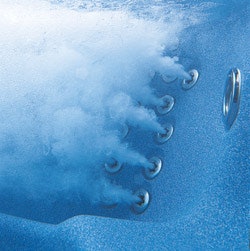
Time will tell, but two spa equipment manufacturers, Gecko Alliance and Pioneer H2O Technologies, are hoping the salt-based trend catches on in the spa industry the same way it has in the pool industry.
Pioneer has had a salt bromine generator on the market for several years, and thus far, according to Randy Hannum, vice president of the Lakewood, Colo.-based company, growth had been good up until the downturn hit the spa market last year.
"It's been our main product and biggest seller by far," he says, "with our biggest growth coming in '06 and '07."
When the market picks up again - as it inevitably will - Hannum believes that the same convenience factor that is driving salt pool generators will drive salt bromine technology as well.
That belief is shared by Gecko, which has just entered the salt bromine generator market with in.clear, a product that uses sodium bromide to produce free bromine in spa water using a chemical reaction similar to that used in a saltwater chlorine generator. The technology used in the in.clear system comes to Gecko via an agreement with Bromitron, an international bromine generation company based in Englewood, Fla., according to Benoit Laflamme, vice president of research and development and marketing.
"It's essentially the technology that Bromitron Co. used to use in pool applications. We took that technology and migrated it to the spa. The big difference is that the salt content in the water is much less than a salt chlorine generator. It's around 1,400 ppm, compared to a salt chlorine generator system, which is over 2,000 ppm."
The lowered salt level is an important benefit, Laflamme adds, because not only does that mean less expenditure for spa salt, but it reduces the potential for corrosion, which is a concern in saltwater environments under certain conditions.
"The technology that makes that possible," he says, "is in the construction of the cell. The surface area of the plates used for electrolysis is much larger, and the flow around them is better."
Both companies are counting on the consumer's lust for convenience to build sales revenues in the future.
"The main advantage of salt bromine systems is the ability of the homeowner to leave the spa for long periods of time without doing anything to it," Laflamme says. "When you come back to it, you can jump right in, because the water has been maintained with a normal bromine level, around 2 ppm. That's a compelling benefit.
"Once it's set up you can leave it alone, as opposed to using bromine tabs where you need to add something at least once a week. You don't have to do that with this product, and it makes it a very low-maintenance spa."
Retailer Reluctance
There is a major difference in the way pools and spas are delivered to the customer that may play a large role in the acceptance of salt bromine systems.
A large percentage of saltwater pool systems have been sold by builders who are unconcerned with ongoing chemical sales, whereas spas are generally sold by a retailer that sells bromine tabs, and who may be less enthusiastic about a system that will obviate their use.
Thus far, Hannum says, retailer reluctance has been an issue in the United States, "but in Canada the product has been welcomed. We've saturated Canada pretty well, and we've begun to get into other countries in Europe where water is a more precious resource, and the less often they have to do drain and fills [a benefit of salt bromine systems], the more appealing the system is.
"It's catching on, but here in the States, we're not where we would like to be - and where we could be."












































